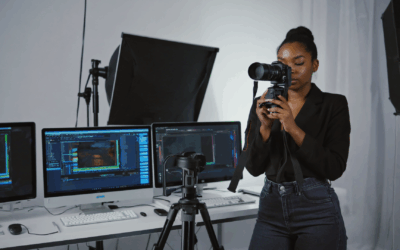In recent years, Artificial Intelligence (AI) has made significant strides in various industries, including photography. The integration of AI within photography has led to the development of industry-changing techniques that have altered the way we capture and process images. In this article, we will explore some of the latest AI-based techniques in photography and how they are revolutionizing the industry.
| Table of Contents |
|---|
AI-Powered Image Editing
One of the most significant advancements that AI has introduced to the photography industry is automated image editing. AI-powered software, such as LuminarAI, uses machine learning algorithms to analyze and enhance your photos. This results in several benefits:
- Time-saving: AI can considerably reduce the time spent on image editing tasks.
- Quality improvements: AI can produce more precise and professional-looking edits.
- Accessibility: The intuitive interface of AI-powered tools makes it easier for beginners to achieve professional results.
Some of the most popular AI-powered tools and features include:
- Sky replacements: With a few clicks, you can replace an overcast sky with a stunning sunset or any other desired backdrop.
- Portrait and skin retouching: AI can quickly detect facial features and make subtle adjustments for flawless portraits.
- Smart contrast adjustments: AI can analyze an image and make contrast adjustments depending on the photographed area, resulting in a more vivid and dynamic image.
Smart Cameras
Modern cameras come equipped with AI features that streamline the process of capturing the perfect shot. These intelligent cameras can automatically detect and track subjects, resulting in improved focus and image quality. Some examples of AI-powered features in smart cameras include:
- Subject tracking autofocus: Cameras use AI technology to identify and track a moving subject within the frame, ensuring sharp and clear images regardless of movement.
- Scene detection: Smart cameras analyze the scene and automatically adjust the settings to capture the best possible image.
- Optical image stabilization: AI algorithms work to reduce blurring and camera shake, helping photographers achieve a steadier shot.
Facial Recognition
AI-driven facial recognition systems have become increasingly popular in photography. These systems enable cameras to detect, recognize, and track faces in real-time, ensuring accurate focus and improved image quality. Facial recognition can be utilized in various applications, such as:
- Portrait photography: Facial recognition helps maintain focus on the subject’s face, even when their position changes, ensuring sharp and expressive portraits.
- Event photography: Cameras can prioritize and capture the most essential expressions and moments as they occur.
- Security and surveillance: AI-powered facial recognition can identify individuals in a crowd, making it a useful tool for law enforcement and security personnel.
Aesthetic Enhancements
AI can analyze a photo’s composition and suggest aesthetic improvements, helping photographers achieve visually pleasing results. Some notable AI-driven aesthetic enhancements include:
- Cropping and framing: AI can suggest optimal cropping dimensions and guide photographers on proper subject placement within the frame.
- Color enhancement: AI algorithms can analyze a photo’s color palette and make subtle adjustments to improve the overall visual appeal.
- Image optimization: AI can identify the critical elements of a photo and optimize them for better exposure and visual balance.
Automated Photo Selection
Sorting through vast collections of images and selecting the best ones can be a daunting task. AI algorithms can now analyze the technical and aesthetic aspects of photos, streamlining the selection process. The benefits of automated photo selection include:
- Time-saving: AI can quickly analyze large sets of images, allowing photographers to focus on other tasks.
- Consistent results: AI selection algorithms consider similar criteria in each assessment, resulting in consistent and objective selections.
- Improved decision-making: AI can provide valuable insights on an image’s strengths and weaknesses, helping photographers make more informed decisions.
AI in Stock Photography
AI technology has also impacted the stock photography industry. It can help photographers improve their images, enhance searchability, and predict market trends, leading to increased sales and better performance. Some key AI applications in stock photography include:
- Keyword suggestion: AI algorithms automate the keyword research process and provide relevant tags based on the image content, leading to improved search engine rankings.
- Content curation: AI can analyze user preferences and browsing history to offer personalized image recommendations.
- Trend forecasting: By analyzing current market trends, AI can identify potential popular themes and subjects, guiding photographers towards more profitable and in-demand content.
Future Trends and Conclusion
The constant evolution of AI technology continues to shape the photography industry by introducing new ways to create and edit images. In the future, we can expect further advancements in AI-driven image editing, intelligent camera features, and smarter content curation in stock photography platforms.
As AI continues to develop and improve, the photography industry will undoubtedly embrace these changes, leading to more efficient workflows and superior results. By staying updated on the latest AI developments, photographers can adapt to new techniques, ultimately enhancing their skills and the quality of their work.




0 Comments